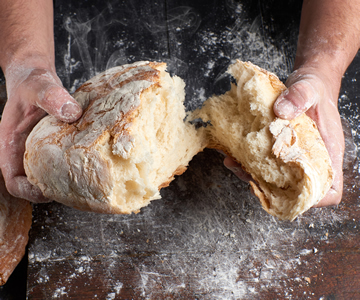[breadcrumb]
What is a Baker?
 Bakers follow the directions of recipes to mix ingredients and make baked goods, such as bread, pastries, cakes and cookies. They prepare these products for sale in their own shops or baked goods sold by grocers, restaurants, wholesalers and other locations. They must use their understanding of food preparation and ingredients to bake goods or create unique recipes for baked goods.
Bakers follow the directions of recipes to mix ingredients and make baked goods, such as bread, pastries, cakes and cookies. They prepare these products for sale in their own shops or baked goods sold by grocers, restaurants, wholesalers and other locations. They must use their understanding of food preparation and ingredients to bake goods or create unique recipes for baked goods.
Typical job duties of bakers include:
- Check the quality of ingredients
- Ensure all ingredients and finished goods meet quality and food safety standards
- Prepare equipment for baking
- Measure and mix raw ingredients
- Weigh flour, sugar and other dry goods
- Decorate items
- Combine measured ingredients in mixers, blenders and other appliances
- Knead, roll and cut dough
- Place dough into bakeware, molds or baking sheets
- Heat food in ovens
- Operate heat sources
- Keep records related to inventory, deliveries and production levels
- Clean and sanitize workstations and baking equipment
- Restock refrigerators and workstations
Some bakers mass-produce baked goods. These are often called production or commercial bakers. They work in factories and other facilities to create a high volume or products that are then sold to grocery stores and other outlets. They must follow instructions on when products must be made.
Retail bakers work in grocery stores, bakeries, restaurants and specialty stops. They often interact directly with customers. These bakers usually create smaller quantities of baked goods, but they may have to take more time to make the products unique.
How Can a Baker Get Mesothelioma by Occupational Exposure to Asbestos?
Asbestos can help prevent fires, so it was used in many applications, including in bakeries and manufacturing plants where baked goods were produced. It was often used as insulation in these facilities and equipment in these plants. Additionally, it was used in fireproofing equipment like gloves. Therefore, bakers and cooks have been exposed to asbestos on a daily basis.
When asbestos is disturbed, microscopic fibers can break off and become airborne. These fibers can then be inhaled by people nearby. They become lodged in the lining of the lungs and may move to other organs. These fibers then form into cancer-causing tumors.
Locations in the United States for the Highest Employment Rates for Bakers
According to the U.S. Bureau of Labor Statistics, there are over 180,000 bakers in the United States. However, with an expected rate of growth of 8%, there are expected to be more than 205,600 bakers by 2026. The states with the highest employment rates for bakers are:
Similar Occupations as Bakers
Occupations that are similar to bakers include:
- Chefs
- Cooks
- Food and tobacco processing workers
- Food preparation workers
- Deli workers
Studies Related to Bakers and Asbestos
The American Journal of Industrial Medicine published a study in 2001 entitled “Malignant pleural mesothelioma in bakers and pastry cooks” about how common mesothelioma was in these industries. Researchers identified eight cases within the group of people examined, including biscuit cooks who engaged in baking, cooking or making pastries or breads. Researchers found asbestos-containing materials in older bread-baking ovens, which was used as a fireproofing material to prevent flames in the oven from damaging other parts of the oven. Those who worked with these ovens could have been exposed to asbestos. Additionally, asbestos could have become dislodged in the oven and fallen into the products that were cooked in it.
Lawsuits and Settlements Involving Bakers and Mesothelioma
Because thousands of people have developed life-threatening diseases like mesothelioma, lung cancer and asbestosis due to their exposure to asbestos, there have been many lawsuits against the manufacturers of asbestos products and the owners of facilities where these products were used. Many of these lawsuits have resulted in multimillion-dollar verdicts and settlements.
Some of the workers who were exposed to asbestos worked in unlikely industries for exposure, such as baking. Because the incident rate of mesothelioma is not as high for bakers as it for mechanics, shipbuilders or asbestos plant workers, there are less cases involving these workers.
Types of Asbestos Products Used by Bakers
Bakers could have been exposed to asbestos through the use of bread-baking machines, insulation in the building, insulation in baking equipment and fireproofing materials.
Manufacturers of Asbestos Products Used by Bakers
Different manufacturers could have produced the products that bakers used during their daily work. Some of the most popular manufacturers of asbestos insulation, which was a commonly used product that contained asbestos, include the following:
- Johns Manville
- R. Grace
- National Gypsum
- Armstrong Contracting and Supply
- Pittsburgh Corning
- Celotex
- Nicolet
- Certainteed Corporation
- Thurston & Sons
- Combustion Engineering
- Crown Cork and Seal
- Owens Corning
- Owens-Illinois
- GAF Corporation
- Kaiser Aluminum
- Ehret Magnesia
- Keasbey & Mattison
- Green Industries
- Unarco
- The Fintkote Company
- Pacor Incorporated
- EaglePicher
- Shook & Fletcher
- Western MacArthur
- Rock Wool Manufacturing
